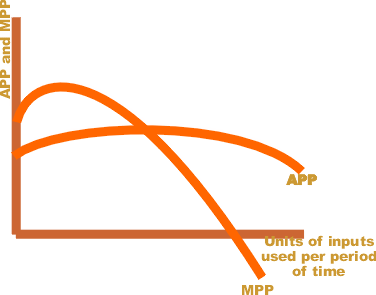Marginal Product on:
[Wikipedia]
[Google]
[Amazon]
 In
In
 In
In economics
Economics () is a behavioral science that studies the Production (economics), production, distribution (economics), distribution, and Consumption (economics), consumption of goods and services.
Economics focuses on the behaviour and interac ...
and in particular neoclassical economics
Neoclassical economics is an approach to economics in which the production, consumption, and valuation (pricing) of goods and services are observed as driven by the supply and demand model. According to this line of thought, the value of a go ...
, the marginal product or marginal physical productivity of an input (factor of production
In economics, factors of production, resources, or inputs are what is used in the production process to produce output—that is, goods and services. The utilised amounts of the various inputs determine the quantity of output according to the rela ...
) is the change in output resulting from employing one more unit of a particular input (for instance, the change in output when a firm's labor is increased from five to six units), assuming that the quantities of other inputs are kept constant.
The marginal product of a given input can be expressed
as:
:
where is the change in the firm's use of the input (conventionally a one-unit change) and is the change in the quantity of output produced (resulting from the change in the input). Note that the quantity of the "product" is typically defined ignoring external costs and benefits.
If the output and the input are infinitely divisible, so the marginal "units" are infinitesimal, the marginal product is the mathematical derivative
In mathematics, the derivative is a fundamental tool that quantifies the sensitivity to change of a function's output with respect to its input. The derivative of a function of a single variable at a chosen input value, when it exists, is t ...
of the production function
In economics, a production function gives the technological relation between quantities of physical inputs and quantities of output of goods. The production function is one of the key concepts of mainstream economics, mainstream neoclassical econ ...
with respect to that input. Suppose a firm's output ''Y'' is given by the production function:
:
where ''K'' and ''L'' are inputs to production (say, capital and labor, respectively). Then the marginal product of capital (''MPK'') and marginal product of labor (''MPL'') are given by:
:
:
In the law of diminishing marginal returns, the marginal product initially increases when more of an input (say labor) is employed, keeping the other input (say capital) constant. Here, labor is the variable input and capital is the fixed input (in a hypothetical two-inputs model). As more and more of variable input (labor) is employed, marginal product starts to fall. Finally, after a certain point, the marginal product becomes negative, implying that the additional unit of labor has ''decreased'' the output, rather than increasing it. The reason behind this is the diminishing marginal productivity of labor.
The marginal product of labor is the slope of the total product curve, which is the production function plotted against labor usage for a fixed level of usage of the capital input.
In the neoclassical theory of competitive markets, the marginal product of labor equals the real wage. In aggregate models of perfect competition, in which a single good is produced and that good is used both in consumption and as a capital good, the marginal product of capital equals its rate of return
In finance, return is a profit on an investment. It comprises any change in value of the investment, and/or cash flows (or securities, or other investments) which the investor receives from that investment over a specified time period, such as i ...
. As was shown in the Cambridge capital controversy, this proposition about the marginal product of capital cannot generally be sustained in multi-commodity models in which capital and consumption goods are distinguished.Kurz, Heinz D. and Neri Salvadori (1995) ''Theory of Production: A Long-Period Analysis''. Cambridge University Press.
Relationship of marginal product (MPP) with the total product (TPP)
The relationship can be explained in three phases- (1) Initially, as the quantity of variable input is increased, TPP rises at an increasing rate. In this phase, MPP also rises. (2) As more and more quantities of the variable inputs are employed, TPP increases at a diminishing rate. In this phase, MPP starts to fall. (3) When the TPP reaches its maximum, MPP is zero. Beyond this point, TPP starts to fall and MPP becomes negative.See also
* Marginal product of labor * Marginal product of capital * Marginal revenue productivity theory of wages *Marginal cost
In economics, the marginal cost is the change in the total cost that arises when the quantity produced is increased, i.e. the cost of producing additional quantity. In some contexts, it refers to an increment of one unit of output, and in others it ...
* Production theory
* Average product
*Cost of production
Manufacturing cost is the sum of costs of all resources consumed in the process of making a product. The manufacturing cost is classified into three categories: direct materials cost, direct labor cost and manufacturing overhead. It is a factor i ...
* Shadow price
References
Further reading
* * {{Authority control Production economics Marginal concepts